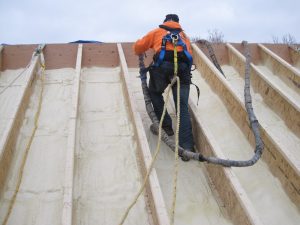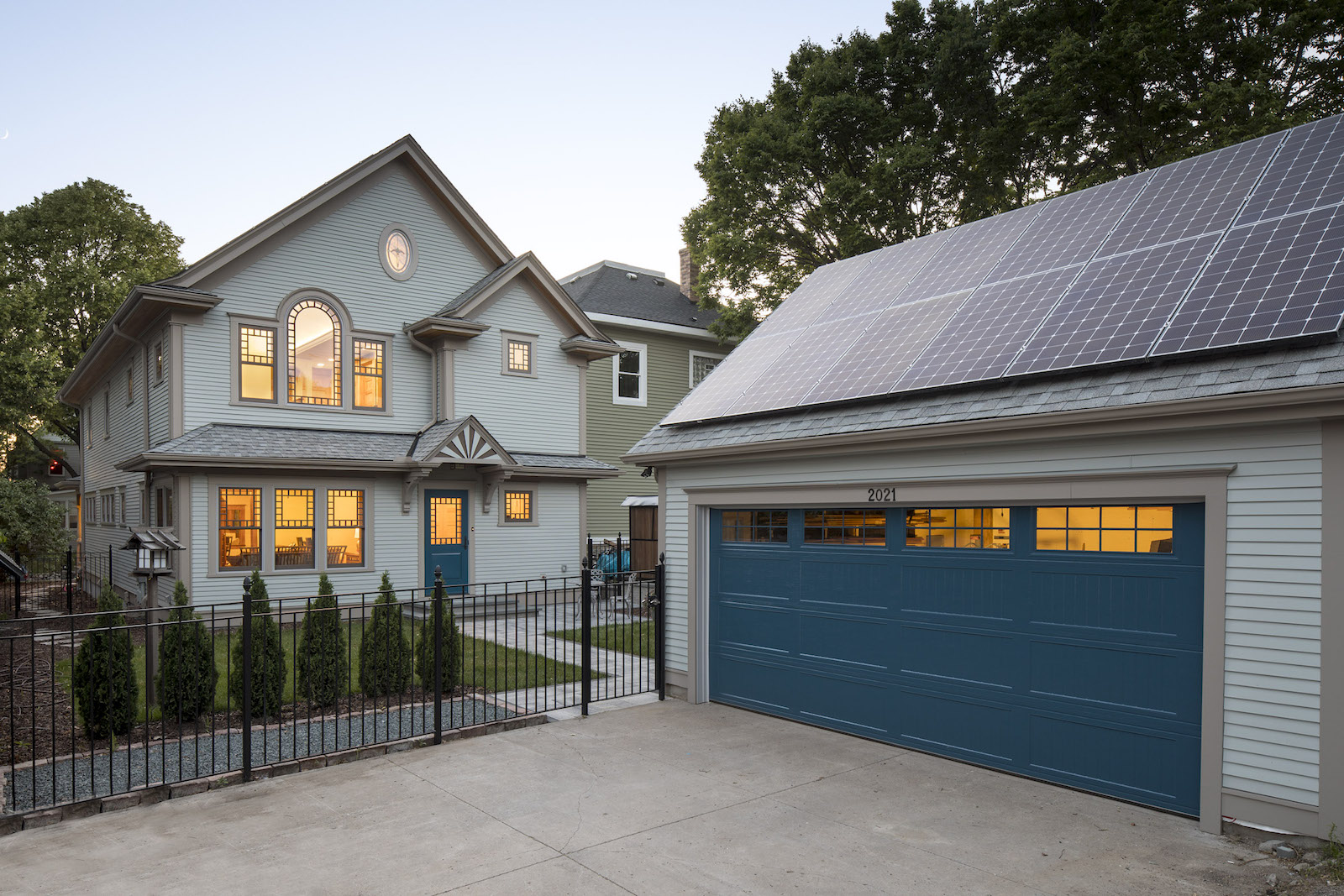In 2014, I learned about net zero energy at the Minneapolis Home & Garden Show. Shortly thereafter, my wife and I purchased our retirement home and interviewed five sets of architects to compose the core of the design team. We settled on Marc Sloot of SALA Architects and Sean Morrissey of Morrissey Builders in St. Paul, both with considerable experience in sustainable design and construction. The result is our “Net Zero Victorian,” showing that a standard city house on a standard city lot in chilly Minneapolis can be renovated to be net zero in energy with no sacrifice in attractiveness, space, or comfort.
Design Process
The design and permitting took more than a year, beginning in August 2014 through the end of 2015. We sought a variance in local zoning since the exterior walls on one side of the house were already over the side yard setback from the property line, and then added one foot of exterior insulation, which moved the exterior wall surface even closer to the property line. This kind of variance was unusual for the Minneapolis community economic planning and development board. We also requested approval for a 500-square-foot addition – just within the legal limits for the lot. After four months (late 2015-early 2016), approval was granted for both.
Construction process
Construction took 15 months (twice as long as we anticipated), from September 2015 through December 2016, although we were able to move in by late October 2016. Delays were due to adjustments in what needed to be done, scheduling problems, difficulties of constructing the envelope in the middle of winter, the level of detail required, particularly for interior Victorian style woodwork, and an insufficient number of skilled craftsmen. The exterior walls required multiple layers – OSB, EPS blocks, window frame boxes, plywood sheathing, furring strips and lap siding – all of which generated a more extended period of construction noise than is usual.
Four “Legs” of the Net Zero “Stool”
Efficient insulation, effective air and moisture barriers, reduced energy consumption, and sources of renewable energy for both heating/cooling and electricity were the biggest drivers for the design and energy outcome of the home.
Insulation: Typically, old houses are insulated by tearing out the interior plaster and putting in fiberglass batts, or punching holes in the walls to fill with cellulose. This house was insulated on the outside by attaching a 7.25” thick layer of rigid insulation board giving us R-40 in the walls. The rigid foam used was expanded polystyrene (EPS), with 1000 times less environmental impact than extruded polystyrene (XPS).We also sprayed in expandable closed-cell spray foam between the rafters of a new roof to achieve R-80 (see below). A tight house also needs to keep heat in the basement from leaking out. Typically, the foundation wall is insulated on the inside – not very effective – or by digging a deep wide trench –which makes a huge mess. Our renovation was one of the first in Minneapolis to use the “Cocoon” method of sucking out a four-inch wide slice of dirt all the way down to the footings of the foundation, then inserting a one-inch foam sheet and three inches of sprayed closed-cell foam. The net insulating effect for the basement was R-30 while removing very little dirt. The house has triple-glazed Anderson A-series windows throughout, further reducing heat loss.

The high-density spray foam placed between roof rafters created an insulating value of R-60. A new foam chemistry has a much lower global warming potential than earlier spray foam formulations.
Air and Moisture Tightness: Much heat and moisture is lost through leaky walls. We wrapped the house in a sticky membrane made by 3M (3015 air moisture barrier). It prevents moisture from becoming trapped and causing mold or rot. Forty percent of the insulation is inside the 3M barrier, so moisture will evaporate back into the living space where humidity averages a comfortable 40-50%. Sixty percent of the insulation is outside the 3M barrier but inside a Tyvek barrier. Air (and moisture) are allowed to circulate freely under the siding without entering the house. Our house is almost five times tighter than the building code requires, and happens to meet the standard for super efficient “passive” houses (.05cfm@50Pa). It is ventilated by an ERV (enthalpy recovery ventilator), drawing exhaust air from the kitchen and bathrooms. When the range hood operates, makeup air is drawn from outside past the refrigerator coils for more efficiency.
Formaldehyde is poisonous gas given off by plywood and some forms of insulation. Formaldehyde is a threat to health, and our house is so tight that inadvertent leakage would do nothing to reduce the threat. To combat this, we installed Certainteed’s “AirRenew” wallboard which absorbs formaldehyde and renders it inert for a promised ten years.
Reduced Energy Consumption: The house uses three heat pumps: a three-ton geothermal heat pump, with a COP of 5.0, a heat-pump-driven water heater, and a heat-pump-driven ventless clothes dryer.
We disconnected our natural gas line and made the house all-electric. For heating and cooling, four linked geothermal wells were drilled in the 30 x 40 foot backyard. The wells are each 250’ deep, in a diamond pattern 10 feet on a side. The yield is four tons for cooling/heating.
One lament of old-home owners is that they must run the faucet a long time to get truly hot water from their centrally located water heaters. Our hot water typically arrives within five seconds, saving water, and energy. To accomplish this, our plumbers installed a recirculation loop of thickly insulated (R-4) piping inside the building envelope. A pump quickly moves hot water from the tank to the sinks. To save energy, the pump is activated by motion detectors – people entering the kitchen or bathrooms.
All lighting is LED, whether in traditional fixtures, cans, or other locations.
Recycling heat is another way that we reduce energy consumption. In this house, heat is recycled in three ways. 1) The heat exhausted from bathrooms and the kitchen is used to warm incoming outside air through an enthalpy recovery ventilator (ERV). 2) Excess heat from the geothermal heat exchanger pre-heats water in a pre-heat tank for the domestic water heater. 3) Our water heater is driven by a heat pump which sucks heat from basement air – three times more efficient than electric hot water heaters.
Energy is also saved through a new dryer design. Conventional dryers waste energy by heating with an electric coil and then venting warm exhaust outside at the rate of 135 cubic feet per minute. Our Whirlpool dryer (WED99HEDW) generates warm air with a heat pump. Instead of exhausting the warm air to the outside, it condenses the moisture from wet laundry into liquid. The warm liquid water then flows down a drain. No heat is lost to the outside air.
Renewable Energy Source: The house has 54 solar PV collectors (42 on the house and 12 on the garage; 315 watts each) for a 17kW capacity. This system was sized through modeling which initially projected an annual consumption of 19,000 kWh. The actual 2016-2017 output was 17,000 kWh, more than enough to cover 12,000 kWh consumption in the first year.
The 42 collectors on the house weigh 1500 lbs. To support them, a new roof was built over the old crooked and weak “balloon” frame roof. The new roof consists of plywood I-beams and the space between the I-beams is filled with ten inches of closed-cell spray foam, insulating the roof to R-80 (including 6” wide batts between the rafters of the old roof just below). This spray foam employs a recently introduced blowing agent with a far lower greenhouse gas potential (GWP is 1) than other products. Supporting all this new construction is a massive laminated beam running the length of the attic, which workers installed by hand (in six 300-lb pieces) rather than by crane. The beam rests upon steel posts which run down invisibly through the walls to thick foundations in the basement.
Building operation
The home’s operation requires little involvement on a day-to-day basis. The ERV refreshes the interior air twenty minutes per hour. No thermostat setback is needed at night, and humidity is kept to comfortable levels (40-50%) by the operation of the geothermal heat pump. An eGauge system is installed to allow the internet-based monitoring of twenty-four individual electrical circuits throughout the house, while the performance of the solar system is also monitored over the internet through Solaredge software.
Landscaping
Our aim was to create a low-maintenance natural Minnesota environment. The yard is bordered by hardscape frame–Versalok blocks capped with NY Bluestone (also used for the front walk and terracing). 2500 square feet of the yard is planted in a variety of Minnesota perennials, mostly drought tolerant. A three-zone drip irrigation system is installed to carry these eight hundred plants through a dry summer. One-fifth of the yard is planted in Kentucky bluegrass, with no installed irrigation. Managing precipitation is another priority. The house keeps runoff – even from the heaviest of rains – from reaching the street and storm drains. The water is channeled into FloWells, perforated plastic barrels buried underground. These hold the water until it percolates back into the ground.
Results
We have the satisfaction of knowing that we have rescued, renewed, restored, and repurposed a perfectly viable Victorian treasure in a way that preserves its character and demonstrates that a neighborhood can be revitalized without being reduced to a brownfield. The house has achieved –and surpassed – net zero. The energy-conserving measures described here have kept the electricity consumption to 12,000 kW hours for the first year – far less than the 17,000 kW hours we generated from solar panels during the same timeframe. Our house is therefore “net positive”, producing more energy than it uses. This extra energy is sold to our local utility, Xcel Energy, at an effective rate of approximately 20 cents per kW hour. In our first year, the system produced about $3000 worth of electricity, yielding a return of about 7% on the initial investment of $40,000 (after the federal tax credit).
For more information on how this Victorian zero energy retrofit was designed for aging in place, please read Stewart’s blog “Decarbonizing Your Retirement as You Age in Place”


One thought on “Innovations in a 107-Year-Old Net Positive Victorian Retrofit”